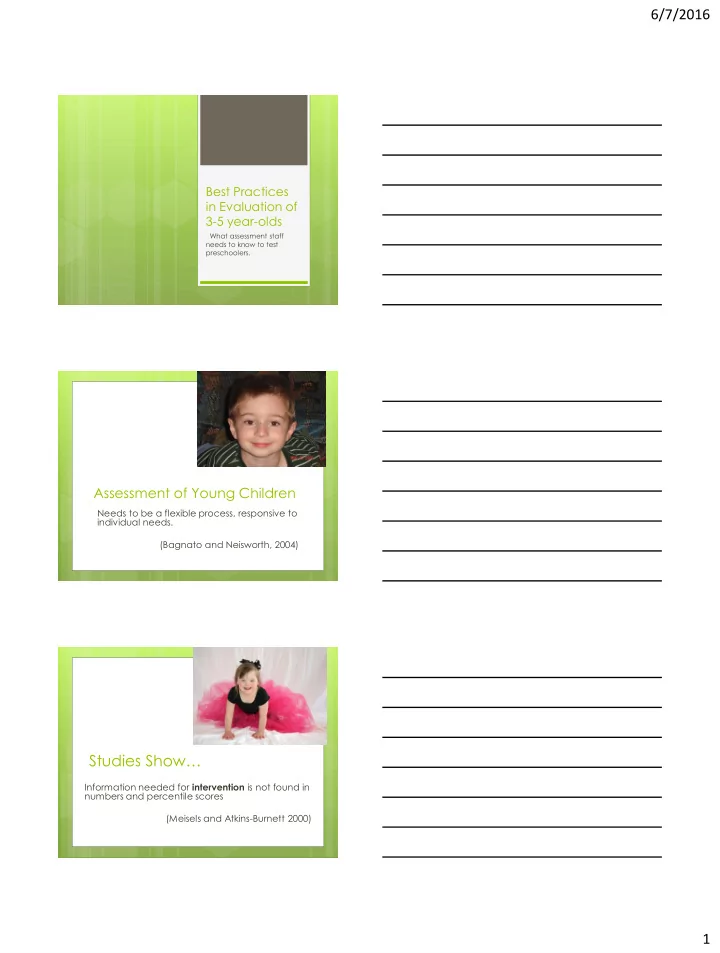

6/7/2016 Best Practices in Evaluation of 3-5 year-olds What assessment staff needs to know to test preschoolers. Assessment of Young Children Needs to be a flexible process, responsive to individual needs. (Bagnato and Neisworth, 2004) Studies Show… Information needed for intervention is not found in numbers and percentile scores (Meisels and Atkins-Burnett 2000) 1
6/7/2016 Experts say… Assessment needs to address interests and intentions as well as skills (Greenspan and Meisels, 1996; Cain and Dweck, 1995) Assessment and intervention need to inform each other in an ongoing manner (McConnell, 2000) Changes needed…. What constitutes an assessment, What questions assessment of young children should examine, What methods should be used to answer these questions, 2
6/7/2016 Changes needed… Who should be involved in gathering assessment data, What the outcomes of an assessment should look like, and, How assessment information should be used (Eisert, & Lamorey, 1996; Meisels & Atkins-Burnett, • 2000; Meltzer & Reid, 1994). Purpose of Assessment Eligibility Disability Need for Specialized Instruction (academic need) Present Levels of Functioning Needs Assessment Plan for Intervention Eligibility Categories Auditory Impairment 1. Autism 2. Deaf-blindness 3. Emotional Disturbance 4. Intellectual Disability 5. Multiple Disabilities 6. Noncategorical Early Childhood 7. Orthopedic Impairment 8. Other Health Impairment 9. Specific Learning Disability 10. Speech Or Language Impairment 11. Traumatic Brain Injury 12. Visual Impairment 13. 3
6/7/2016 Special Circumstances NCEC Early, Accurate Diagnosis is Critical Builds parent trust of staff Get public services earlier Not misleading parents, forcing them to deal with grief again Early intervention is critical Special Circumstances NCEC Multiple Disability Deaf-Blind “The whole is greater than the sum of its parts.” - Aristotle 4
6/7/2016 What tests does the law require? For ID Texas law : Standardized IQ and an Adaptive Behavior measure with multiple areas For AU Federal Law: no test requirements, just areas to cover Types of Assessment Reference Linking Authentic Assessment & Early Childhood Intervention, Second Edition • Bagnato, Neisworth, and Pretti-Frontczak, 2010 Alternative Approaches to Assessing Young Children • Angela Losardo, Angela Notari-Syverson, 2001 5
6/7/2016 Developmental and Screeners ASQ – 3 TPBA ELAP AEPS COR Carolina HELP Brigance Creative Curriculum Devel. Continuum … Standardized Intelligence Tests Standford Binet Intellectual Scales for Early Childhood 5th Edition (Early SB5) WPPSI IV WJ Early Cognitive and Academic Development KABC- II Adaptive Behavior ABAS – 3 Vineland – II TPBA Many Developmental Assessments 6
6/7/2016 Autism ADOS 2 (toddlers-adult) CSBS - Communication and Symbolic Behavior Scales PDDST-II - Pervasive Developmental Disorders Screening Test-II (18 mo and up) A Diagnostic Interview Revised CARS (2y and up) GARS (3-22y) Achievement WJ IV ECAD – ages 2:6-7:11 WIAT III – ages 4 -50 Brigance: writing, reading, math High Scope COR Case Studies 7
6/7/2016 How do we use the data? Purpose of Assessment Eligibility Disability Need for Specialized Instruction (academic need) Present Levels of Functioning Needs Assessment Plan for Intervention Assessment to Intervention Use the data to write your PLAAFP 8
6/7/2016 (Source of data, strength, linked to standards) According to TEST ADMINISTERED, STUDENT NAME is still working/developing his/her skills in the area of NEED , specifically with an instructional focus in FOCUS , STUDENT NAME is currently DATA . (Linked to gen. ed., weakness) This will hinder STUDENT NAME access to the general curriculum because describe the reason why this weakness hinders academic/functional progress or typical students at this age/grade can _______. On the play-based assessment, Ava is still developing her skills in the area of Writing, specifically in the area of motivation to write. Ava currently engages in scribble writing. Most 4 yr olds are able to use letter like forms and actual letters to replace scribble writing. (Source of data, strength, linked to standards) According to TEST ADMINISTERED, STUDENT NAME is still working/developing his/her skills in the area of NEED , specifically with an instructional focus in FOCUS , STUDENT NAME is currently DATA . (Linked to gen. ed., weakness) This will hinder STUDENT NAME access to the general curriculum because describe the reason why this weakness hinders academic/functional progress or typical students at this age/grade can _______. 9
6/7/2016 PLAAFP to IEP By when? Who? Will do? What? How well? Under what conditions? • By when? By the end of the year, • Who? Ava • Will do? will copy • What? The letters of her name • How well? recognizable by others • Under what conditions? with a visual sample. PLAAFP to IEP By when? Who? Will do? What? How well? Under what conditions? 10
6/7/2016 Discussion Brenda Bush, M.Ed. Educational Diagnostician, Preschool Consultant Brenda_bush@yahoo.com 11
Recommend
More recommend